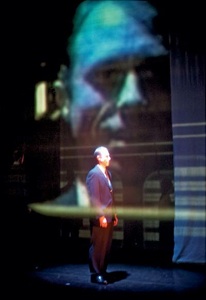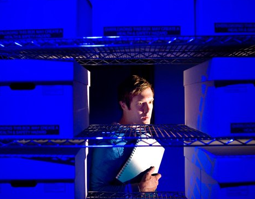Jacob Epstein's Adam (1938-39)
The new-ish
exhibition at the Royal Academy is very much in the contemporary style.
It does not purport to be a survey but rather an argument
about modern British sculpture and, to show how original its thinking
is, contains many objects that are neither modern, British, nor
sculpture.
It’s basically pretty good. There are
some very witty and provocative juxtapositions. The first room contains
banners depicting Epstein’s mistreated BMA sculptures and a smaller
reconstruction of Edwin Lutyens’s Cenotaph in Whitehall. The room
therefore contained, in the definition of the exhibition, sculptures of
sculptures. So far, so witty. The second room, by far the most
cluttered, juxtaposes modernist sculptures with some ancient treasures
brought to Britain in the twentieth century and inspiring the
primitivist strand in the Modernist movement. The clutter is to great
effect because one’s eye initially takes in the whole picture and we see
only continuity and coherence between the geographically and
historically discontinuous pieces; only as you walk around observing the
objects one by one, or in pairs, do you see the complex affiliations
and divergences. In the next two rooms there is a more outrageous
juxtaposition: Jacob Epstein’s Adam
(1938-39), a stunning sculpture of immense power and presence, brutally
physical and with an enormous swinging penis and two full opalescent
balls, juts its face up to the sky, while, through the archway, Alfred
Gilbert’s fussy Jubilee Memorial statue of a bethroned Queen Victoria (1887) looks down with unamused disdain.
Epstein’s Adam,
which I’d never before seen, was the highlight of the exhibition, given
virtually an entire room to itself, and seeming to fill the generous
air around it with energy and sex. It bursts with questions: is this
Adam being born? The face upraised against a new sky, the lungs suddenly
filled with unfamiliar air, the arms still tucked in like those on Leon
Underwood’s Embryo (1924-25) in the
previous room? Or is this the Adam of hubris, puffed up with power, body
swollen with newly-discovered sex, his face set against God? The only
other sculpture in the room is Henry Moore Snake from 1924. Where Adam is in a roseate alabaster, its tones flooding from seminal white to engorged oxblood-red, the Snake is insinuating white marble, swiftly rowled in tangles, to make intricate seem straight.
Barbara Hepworth’s elegantly monumental Single Form (Memorial)
(1961-2) is fascinating and deceptive. Enormous, heavy and dominating,
yes sensuous, hollow and tactile. I found it much more entrancing than
the more familiar Henry Moore that shared its space. Victor Pasmore and
Richard Hamilton’s An Exhibit (1957) was
well presented, filling a room, demanding it be inhabited, allowing the
polished surfaces to reflect each other, changing the inhabitant’s sense
of the wider space, its cheap materials and gaudy colours accumulating a
kind of maze-like complexity of planes, reflections, corners and
volumes.
Things pivot oddly and unsatisfyingly with Anthony Caro’s Early One Morning
(1962). The curators both wanted to acknowledge its conventional
placing in art history - Caro as the student of Moore, we were only two
rooms away from Moore’s Reclining Figure
(1961), which this echoes in its forms - but also wanted to challenge
it. The commentary on the wall plaque was rather mealy-mouthed about the
piece, suggesting that it was perhaps more of an ending than a
beginning. This was a piece that to me didn’t benefit from being given
its own room, nor from being juxtaposed by a nagging, sceptical 1969
essay by William Tucker (oddly saying similar things that Michael Fried
had said about minimalist art in 1967’s ‘Art and Objecthood’, though
Michael Fried had been an early American champion of Caro). The spare
form seemed to be to want friends around it, context for the industrial
elegance to pick up, echo; other sculptures to be seen through it.
And then, for me, it went a bit
downhill. I like a bit of conceptual art, me, but they seemed to pick
some stubbornly minor items: Siobhan Hapaska’s Under Lying (1991), basically 2000 Maltesers in tiny plastic bags on a glass coffee table didn’t reveal its secrets to me. Bill Woodrow’s Electric Fire with Yellow Fish
(1981), in which from a metal electric fire a fish has been cut,
painted yellow and inserted in front of the bar, seemed to me to be
asking no question that needed asking. Damien Hirst’s Let’s Eat Outdoors Today (1990-91) doesn’t go much further than 1990’s A Thousand Years,
and, in this instance, once you realised that many aspects of it (the
suppurating cow head, for example) were artificial, the effect was
blunted.
William Turnbull Parallels (1967)
The minimalist and environmental sections were an exception. Tony Cragg’s Stack (1975) is beautiful; massive, delicate, full of stories, wonderfully balancing chaos and containment. William Turnbull’s Parallels (1967, pictured) is mesmerising and seemed to repay being looked at from every point in the room. Carl Andre’s famous ‘bricks’ (actually Equivalent VIII
[1965]) was awkwardly placed with an ugly grey line around it that
thoroughly interfered with the internal relationships of the work and
Richard Long’s Chalk Line (1984) had its
impact blunted by being placed on a zigzagging wooden floor. Others have
wondered where Anthony Gormley and Rachel Whiteread were. You don’t
expect completism but I found it a rather odd view of the last hundred
years, as if the curators were trying to say that contemporary sculpture
has basically got a bit shit. I’m prepared to believe that they think
there’s unsettling power and wit in Grenville Davey’s Right 3rd and 6th (1989), but not that they think the whole room can compare with Jacob Epstein’s Adam, in any way.
It is worth seeing, and perhaps they want you to argue passionately with their choices - and, yada yada, they’ve kind of made their choices explicit, so you can argue - but you’ll have to argue - and bring your own memories of other work.



![photo[1].jpg](https://images.squarespace-cdn.com/content/v1/513c543ce4b0abff73bc0a82/1362919072201-PZO854G4SEB794DVOEI8/photo%5B1%5D.jpg)
